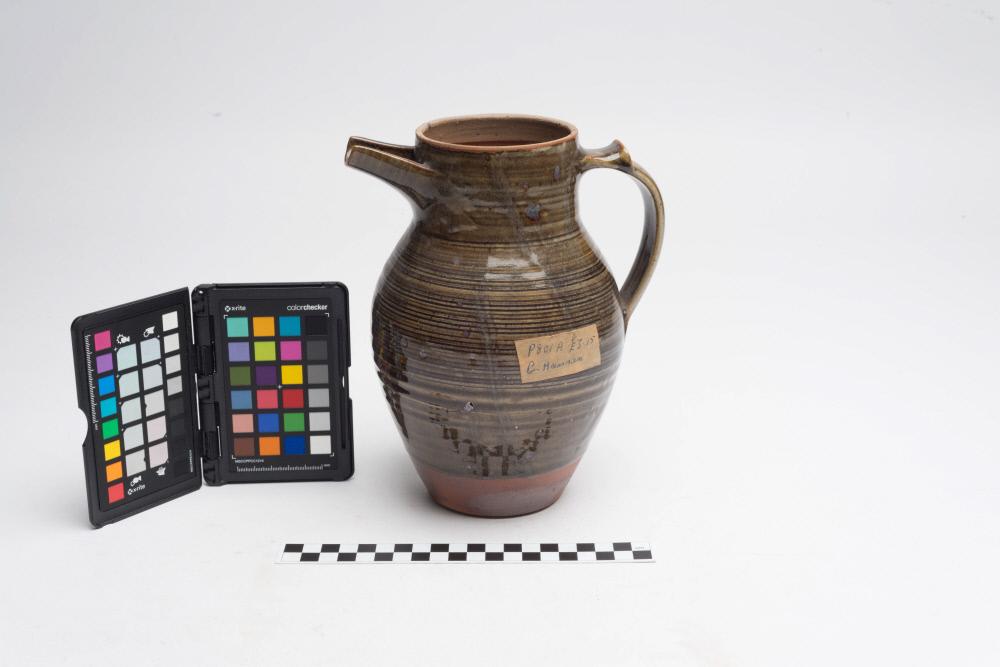Just like Susan Wynter’s Noah’s Ark set – the item that triggered my engagement with the digitised Camberwell ILEA Collection in reflecting on environmental themes – Gwyn Hanssen’s Glazed Ceramic Jug made me think about the obvious subject of water. For our world to be often referred to as 'the blue planet', I found it surprising to find out that less that 3% of the world’s water is fresh water. And even then, most of this fresh water is frozen as snow or ice and located either in the Arctic and Antarctic, which then leaves the remaining sources of fresh water: rivers, lakes and underground in the form of groundwater.

Immediately, I thought of the obvious connection this object has to our society and the growing scarcity of this resource. Conflicts and political tensions many of us have seen on the news have usually revolved around oil. But the subject of water scarcity hasn’t gripped our consciousness quite so acutely. There have been the long-running disputes over the Nile Basin, tensions over the rivers Euphrates and Tigris concerning Turkey, Syria and Iraq, the privatisation of water in Bolivia, and the growing tensions surrounding China’s Mekong River Basin, whose water flows through much of South-East Asia: Myanmar, Laos, Thailand, Cambodia and Vietnam.
But even how we as a society then use this limited resource is further cause for alarm. Over 70% of our freshwater goes to farming, while the remainder goes to industrial process which use up what is called 'Virtual Water'. Take clothing for example. Water is required to irrigate the fields on which cotton plants are grown. Then the processing of colouring, rinsing and bleaching cotton in jean manufacturing requires even more water. And this industrial process goes on to pollute the limited supply of freshwater available, dwindling resources even further.
It takes over 10,000 litres of water to produce a single pair of jeans. Oxfam have quantified this:
So, it begs the question - how many pairs of jeans do we own, have ever owned, will ever own? Then, multiply that with 13 years of drinking water per person. Then let’s look at food. It takes around 20,000 litres of water to produce a single kilo of coffee. For 1 kilo gram of beef, virtual water consumption totals around 15,000 litres of water.
It’s no wonder that in the last decades, we have seen what were once great bodies of water - such as the Aral Sea or Africa’s Lake Chad, which shrank as much as 95% from its original size between 1963 to 1998 – slowly disappear. What would have taken thousands of years to form is disappearing within a lifetime.

So, when viewing Gwyn Hanssen’s glazed ceramic jug, I imagine it encased in a glass box, perched on top of a stand, in the middle of a room, curated in a museum, with lights focused on it. And if one looks closely on the inside, it would be water stained. And written on the display case’s description would be something along the lines of:
Mid-Twentieth Century Glazed, Ceramic Jug, stained by the ancient waters of the once great Lake (Insert Name: _ _ _ _ ), before it disappeared altogether in the year (Insert Year: _ _ _ _ ), after decades upon decades of ground water depletion, wasteful irrigation practices, and the inevitable effects of climate change wrought by the actions and inactions of the human race since the beginning of the Anthropocene age. The lake did, however, allow for the successful production of millions if not billions of jeans, mostly seasonal in style with few, if hardly any, timeless varieties, all courtesy of the time period’s societal obsession with fast fashion starting from the 20th and continuing into the 21st century.
This museum exhibit would take place in the year 3,500 CE. And, possibly, on Mars.

